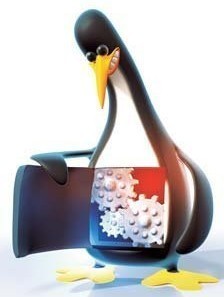Kernel log: new gfx drivers for GeForce & Radeon GPUs; Kernel Track at LinuxTAG
 Nvidia has released version 173.14.05 of its proprietary Linux graphics driver to download. For the first time, it not only supports new GeForce models, such as those in the 9600 and 9800 series, but also works with the current beta versions of X Server 1.5 intended for X.org 7.4. A few days ago, X and Fedora developer Adam Jackson published such a driver after he had already integrated a somewhat older beta version in the recently released Fedora 9. Some users who want to see open-source software used exclusively on Linux distributions criticised this move because older versions of the Nvidia driver did not work with the beta version of X-Server, forcing Fedora 9 users of Nvidia hardware to use the open source graphics driver "nv", which only provided basic functions. But, as the ensuing discussion showed, some users and developers were quite pleased about the improvements that the new X Server and its open source drivers provide.
Nvidia has released version 173.14.05 of its proprietary Linux graphics driver to download. For the first time, it not only supports new GeForce models, such as those in the 9600 and 9800 series, but also works with the current beta versions of X Server 1.5 intended for X.org 7.4. A few days ago, X and Fedora developer Adam Jackson published such a driver after he had already integrated a somewhat older beta version in the recently released Fedora 9. Some users who want to see open-source software used exclusively on Linux distributions criticised this move because older versions of the Nvidia driver did not work with the beta version of X-Server, forcing Fedora 9 users of Nvidia hardware to use the open source graphics driver "nv", which only provided basic functions. But, as the ensuing discussion showed, some users and developers were quite pleased about the improvements that the new X Server and its open source drivers provide.
A number of improvements have also been made to open source graphics drivers for AMD/ATI's recent Radeon CPUs. In his blog, Dave Airlie writes that he collaborated with another developer to remedy numerous bugs in the code for 3D support for the R500 GPUs used with Radeon-X1000 graphics cards; he says that Compiz now runs smoothly and UT2004 no longer crashes. He plans to include these corrections in developer branches of the various components (including the kernel, libdrm, and mesa); Fedora 9 can expect to receive these changes and a new X graphics driver called "radeon" as a regular update soon.
Matthias Hopf also announced in his blog that the developer branch of the open source driver radeonhd now also supports DRI, though it has to be manually enabled, and not everything has been properly tested. Now, radeonhd also supports AMD's 780G motherboard graphics chipset; radeon already supported it because it, unlike radeonhd, is based on AMD's AtomBIOS.
During Kernel Tracks at LinuxTAG, David S. Miller provided an insider's view of the Linux network stack in his keynote address. He provided details about which improvements developers are planning for the Linux network stack to improve throughput and reduce the load on the CPU. In his presentation entitled "Linux Kernel – Quo vadis?", Thomas Gleixner of Linutronix analysed problems in the developer process for Linux and described some possible solutions; he also provided an overview of the changes planned in the near future. The developer of UIO (Userspace I/O), Hans-Jürgen Koch, had previously explained how UIO drivers are developed in an earlier presentation. He emphasized that the user part of the driver should be put under an open-source license even though it does not have to be. Gerd 'Kraxel' Hoffmann then provided an overview of current developments concerning virtualisation solutions KVM, Lguest, and Xen and the techniques they use, such as paravirt_ops-Interface. He also described Xenner, which allows paravirtualised Xen guests to be executed under Xen.
Kernel log in brief:
- Linus Torvalds has released 2.6.26-rc4, the fourth release candidate of Linux 2.6.26 . It corrects a number of problems with PAE kernels.
- At LKML, Theodore Ts'o announced that Linux Kernel Summit 2008 will be taking place in mid-September in Portland, Oregon.
- X developers have added support for MPX (Multi-Pointer X) to the code management system. Contrary to expectations, MPX now also supports graphics tablets, though the function will not be part of X.org 7.4, but rather of X.org 7.5.
- The Mesa Project has published Release Candidate 1 of Mesa 7.1.
- The Ndiswrapper team has published version 1.53 of Ndiswrapper.
(trk)
![Kernel Log: Coming in 3.10 (Part 3) [--] Infrastructure](/imgs/43/1/0/4/2/6/7/2/comingin310_4_kicker-4977194bfb0de0d7.png)

![Kernel Log: Coming in 3.10 (Part 3) [--] Infrastructure](/imgs/43/1/0/4/2/3/2/3/comingin310_3_kicker-151cd7b9e9660f05.png)
















